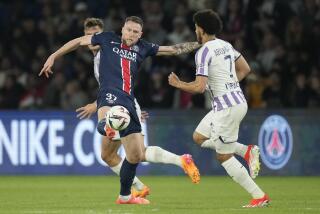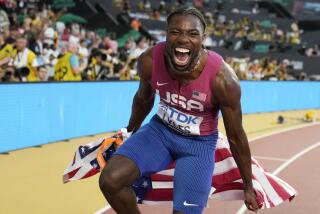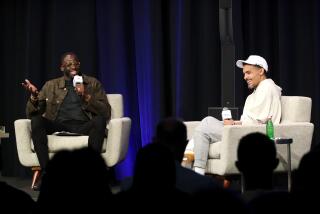‘Desert Prince’ Returns : Track: Starting out on the comeback trail, former Olympic and world champion Said Aouita has Atlanta ’96 in his sights.
- Share via
He was surrounded for many years by dozens of people wherever he went--a manager, a trainer, family members, reporters, photographers, fans, even a bodyguard. Now, on a Thursday night in Century City, Said Aouita, looking smaller than life, sits in Prime Sports’ version of the green room while waiting to be summoned for a one-minute taped interview.
The Moroccan, one of the greatest runners of all time, smiles and makes small talk until he is called to meet the interviewer, whose first question, before the microphone is switched on, is how to pronounce his name. Writers are taught to ask their subjects how to spell their names, and broadcasters ask how to pronounce them in order to avoid mistakes. Still, in many parts of the world, asking Aouita to pronounce his name would be like asking Michael Jordan.
But Aouita does not seem offended, answering graciously. “Sa-EED Ah-WE-ta.” Along with the entourage, also absent from the Aouita who last appeared in Los Angeles at an indoor track and field meet in 1989 is his enormous self-assurance, an air of invincibility that perhaps was necessary in someone who vowed to conquer every distance from 800 to 10,000 meters. His boasts might have been harder to accept if he had not almost done it.
The question now, even in his own mind, is whether he can conquer tonight’s mile in the Sunkist Invitational at the Sports Arena, and when he is asked about it by the television interviewer, Aouita admits: “I’m just coming back, you know. I’m not in great shape, you know. I didn’t train for three years. If I am 25, I can go to the Sunkist and run. If I am 35, I go and see what happens.”
In his vulnerability, there is charm. Perhaps it was always there for those closest to him, but the word most often used to describe him in his prime was aloof. He was seldom accessible, but, in his defense, there was hardly enough of him to go around for everyone who had a request. He was so popular in Morocco that King Hassan II named a train after him.
But on this visit to Los Angeles, Aouita went to dinner with a reporter after his interview at Prime Sports and then rose early Friday morning to accommodate a local television news show that wanted to film him running through the streets.
After splitting time during the last three years between his homes in San Diego and Casablanca, he now conducts interviews in English, unnecessarily apologizing that he does not speak that language as well as he does French, Italian, Spanish, Portuguese and Arabic.
Words fail him only when he attempts to describe his injuries. Instead of talking about them, he bends over to roll up his pants legs, revealing scars that cover the length of both calf muscles.
Cut short was one of the sport’s most remarkable careers. Of all the outstanding male track and field athletes in the 1980s, three stood above the rest--Carl Lewis, Sergei Bubka and Aouita.
A soccer player as a youth who did not begin running seriously until he was 18 or compete internationally until he was 20, Aouita won only two major outdoor titles--the 1984 Summer Olympics and the 1987 World Championships, both in the 5,000 meters.
But between 1985 and ‘89, he set world records in the 1,500, the 2,000, the 3,000, the two-mile and the 5,000. His 2,000 record, more than seven years old, still stands. He held records in the 1,500 for more than seven years and the two-mile for more than six.
His range was unprecedented. Four years after winning the Olympic gold medal at 5,000 meters, he finished third in 1988 at Seoul in the 800 and probably would have won if not for a hamstring injury. Two years before, in his only serious 10,000, he won the event at the prestigious Bislett Games in Oslo, Norway.
But in 1990, he could run no more without pain. Doctors diagnosed Compartment Syndrome in both calves, a condition often caused by overuse of the muscles, and operated.
He was advised against running for one year, but, hoping to compete in the 1991 World Championships, he returned after only three months and did such damage to his calves that he was unable to train again until last year.
Meantime, he took an office job as director of Morocco’s track and field federation, grew to 160 pounds--35 over his ideal weight--and watched another Northern African, Algeria’s Noureddine Morceli, replace him as “the prince of the desert.”
Unfulfilled, he decided to come back this year. Meet promoters will pay him about a third in appearance fees of his asking price from five years ago, and he has no shoe or apparel contract, but he says he is not running for the money.
“I love competition, and, when I see athletes my age who are still around, I ask myself, ‘Why not me?’ ” he says. “A few years ago, people thought an athlete’s career was over at 30. That’s not true anymore. Look at people like (Linford) Christie and (Merlene) Ottey, who became world champions at 33. Look at Carl Lewis. Above all, it’s a question of love for the sport.”
He has no expectations, thus was not disappointed with his only race so far this season, a fourth-place finish in the 3,000 meters last month at Hamilton, Canada.
“I train very hard, but I know I can do nothing this year,” he says. “I have speed, and I have endurance, but I need power. Maybe next year. Maybe in 1996 in Atlanta. I would like to run the 5,000, maybe the 10,000 too.
“Sure, I might not be able to do it. But I am only making a comeback for pleasure. If it works, fine. If not, too bad.”
More to Read
Go beyond the scoreboard
Get the latest on L.A.'s teams in the daily Sports Report newsletter.
You may occasionally receive promotional content from the Los Angeles Times.






